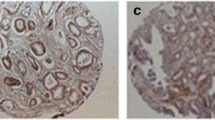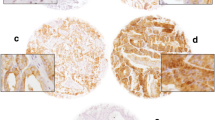Abstract
Background
The scarcity of effective therapeutic approaches for prostate cancer (PCa) has encouraged steadily growing interest for the identification of novel antigenic targets. Placenta-specific 1 (PLAC1) is a novel cancer–testis antigen with reported ectopic expression in a variety of tumors and cancer cell lines. The purpose of the present study was to investigate for the first time the differential expression of PLAC1 in PCa tissues.
Methods
We investigated the differential expression of PLAC1 in PCa, high-grade prostatic intraepithelial neoplasia (HPIN), benign prostatic hyperplasia (BPH), and nonneoplastic/nonhyperplastic prostate tissues using microarray-based immunohistochemistry (n = 227). The correlation of PLAC1 expression with certain clinicopathological parameters and expression of prostate-specific antigen (PSA), as a prostate epithelial cell differentiation marker, were investigated.
Results
Placenta-specific 1 (PLAC1) expression was increased in a stepwise manner from BPH to PCa, which expressed highest levels of this molecule, while in a majority of normal tissues, PLAC1 expression was not detected. Moreover, PLAC1 expression was positively associated with Gleason score (p ≤ 0.001). Interestingly, there was a negative correlation between PLAC1 and PSA expression in patients with PCa and HPIN (p ≤ 0.01). Increment of PLAC1 expression increased the odds of PCa and HPIN diagnosis (OR 49.45, 95 % CI for OR 16.17–151.25).
Conclusion
Our findings on differential expression of PLAC1 in PCa plus its positive association with Gleason score and negative correlation with PSA expression highlight the potential usefulness of PLAC1 for targeted PC therapy especially for patients with advanced disease.




Similar content being viewed by others
Abbreviations
- BPH:
-
Benign prostatic hyperplasia
- CI:
-
Confidence interval
- DAB:
-
Diaminobenzidine
- HPIN:
-
High-grade prostatic intraepithelial neoplasia
- IHC:
-
Immunohistochemistry
- OR:
-
Odds ratio
- PAP:
-
Prostate acid phosphatase
- PCa:
-
Prostate cancer
- PLAC1:
-
Placenta-specific 1
- PSA:
-
Prostate-specific antigen
- TMA:
-
Tissue microarray
- TRUS:
-
Transrectal ultrasound
References
Slovin SR (2012) Toward maximizing immunotherapy in metastatic castration-resistant prostate cancer–rationale for combinatorial approaches using chemotherapy. Front Oncol 2:43
Agarwal N, Sonpavde G, Sternberg CN (2012) Novel molecular targets for the therapy of castration-resistant prostate cancer. Eur Urol 61:950–960
Di Lorenzo G, Buonerba C, Kantoff PW (2011) Immunotherapy for the treatment of prostate cancer. Nat Rev Clin Oncol 8:551–561
Lang SH, Frame FM, Collins AT (2009) Prostate cancer stem cells. J Pathol 217:299–306
Collins AT, Berry PA, Hyde C, Stower MJ, Maitland NJ (2005) Prospective identification of tumorigenic prostate cancer stem cells. Cancer Res 65:10946–10951
Patrawala L, Calhoun T, Schneider-Broussard R, Li H, Bhatia B, Tang S, Reilly JG, Chandra D, Zhou J, Claypool K, Coghlan L, Tang DG (2006) Highly purified CD44 + prostate cancer cells from xenograft human tumors are enriched in tumorigenic and metastatic progenitor cells. Oncogene 25:1696–1708
Patrawala L, Calhoun-Davis T, Schneider-Broussard R, Tang DG (2007) Hierarchical organization of prostate cancer cells in xenograft tumors: the CD44 + alpha2beta1 + cell population is enriched in tumor-initiating cells. Cancer Res 67:6796–6805
Pfeiffer MJ, Schalken JA (2010) Stem cell characteristics in prostate cancer cell lines. Eur Urol 57:246–254
Abrahamsson PA, Lilja H, Falkmer S, Wadstrom LB (1988) Immunohistochemical distribution of the three predominant secretory proteins in the parenchyma of hyperplastic and neoplastic prostate glands. Prostate 12:39–46
Feiner HD, Gonzalez R (1986) Carcinoma of the prostate with atypical immunohistological features: clinical and histologic correlates. Am J Surg Pathol 10:765–770
Gallee MP, Visser-de Jong E, van der Korput JA, van der Kwast TH, ten Kate FJ, Schroeder FH, Trapman J (1990) Variation of prostate-specific antigen expression in different tumour growth patterns present in prostatectomy specimens. Urol Res 18:181–187
Qin J, Liu X, Laffin B, Chen X, Choy G, Jeter CR, Calhoun-Davis T, Li H, Palapattu GS, Pang S, Lin K, Huang J, Ivanov I, Li W, Suraneni MV, Tang DG (2012) The PSA(-/lo) prostate cancer cell population harbors self-renewing long-term tumor-propagating cells that resist castration. Cell Stem Cell 10:556–569
Madu CO, Lu Y (2010) Novel diagnostic biomarkers for prostate cancer. J Cancer 1:150–177
Cocchia M, Huber R, Pantano S, Chen EY, Ma P, Forabosco A, Ko MS, Schlessinger D (2000) PLAC1, an Xq26 gene with placenta-specific expression. Genomics 68:305–312
Fant M, Farina A, Nagaraja R, Schlessinger D (2010) PLAC1 (Placenta-specific 1): a novel, X-linked gene with roles in reproductive and cancer biology. Prenat Diagn 30:497–502
Silva WA Jr, Gnjatic S, Ritter E, Chua R, Cohen T, Hsu M, Jungbluth AA, Altorki NK, Chen YT, Old LJ, Simpson AJ, Caballero OL (2007) PLAC1, a trophoblast-specific cell surface protein, is expressed in a range of human tumors and elicits spontaneous antibody responses. Cancer Immun 7:18
Fant M, Weisoly DL, Cocchia M, Huber R, Khan S, Lunt T, Schlessinger D (2002) PLAC1, a trophoblast-specific gene, is expressed throughout pregnancy in the human placenta and modulated by keratinocyte growth factor. Mol Reprod Dev 63:430–436
Massabbal E, Parveen S, Weisoly DL, Nelson DM, Smith SD, Fant M (2005) PLAC1 expression increases during trophoblast differentiation: evidence for regulatory interactions with the fibroblast growth factor-7 (FGF-7) axis. Mol Reprod Dev 71:299–304
Koslowski M, Sahin U, Mitnacht-Kraus R, Seitz G, Huber C, Tureci O (2007) A placenta-specific gene ectopically activated in many human cancers is essentially involved in malignant cell processes. Cancer Res 67:9528–9534
Jackman SM, Kong X, Fant ME (2012) Plac1 (placenta-specific 1) is essential for normal placental and embryonic development. Mol Reprod Dev 79:564–572
Chen J, Pang XW, Liu FF, Dong XY, Wang HC, Wang S, Zhang Y, Chen WF (2006) PLAC1/CP1 gene expression and autologous humoral immunity in gastric cancer patients. Beijing Da Xue Xue Bao 38:124–127
Dong XY, Peng JR, Ye YJ, Chen HS, Zhang LJ, Pang XW, Li Y, Zhang Y, Wang S, Fant ME, Yin YH, Chen WF (2008) Plac1 is a tumor-specific antigen capable of eliciting spontaneous antibody responses in human cancer patients. Int J Cancer 122:2038–2043
Tchabo NE, Mhawech-Fauceglia P, Caballero OL, Villella J, Beck AF, Miliotto AJ, Liao J, Andrews C, Lele S, Old LJ, Odunsi K (2009) Expression and serum immunoreactivity of developmentally restricted differentiation antigens in epithelial ovarian cancer. Cancer Immun 9:6
Ghods R, Ghahremani MH, Darzi M, Mahmoudi AR, Yeganeh O, Bayat AA, Pasalar P, Jeddi-Tehrani M, Zarnani AH (2014) Immunohistochemical characterization of novel murine monoclonal antibodies against human placenta-specific 1. Biotechnol Appl Biochem 61:363–369
Epstein JI, Allsbrook WC, Amin MB, Egevad LL (2005) The 2005 International Society of Urological Pathology (ISUP) consensus conference on Gleason grading of prostatic carcinoma. Am J Surg Pathol 29:1228–1242
Cheng L, Montironi R, Bostwick DG, Lopez-Beltran A, Berney DM (2012) Staging of prostate cancer. Histopathology 60:87–117
Kononen J, Bubendorf L, Kallioniemi A, Barlund M, Schraml P, Leighton S, Torhorst J, Mihatsch MJ, Sauter G, Kallioniemi OP (1998) Tissue microarrays for high-throughput molecular profiling of tumor specimens. Nat Med 4:844–847
Mohsenzadegan M, Madjd Z, Asgari M, Abolhasani M, Shekarabi M, Taeb J, Shariftabrizi A (2013) Reduced expression of NGEP is associated with high-grade prostate cancers: a tissue microarray analysis. Cancer Immunol Immunother 62:1609–1618
Mahmoudi AR, Zarnani AH, Jeddi-Tehrani M, Katouzian L, Tavakoli M, Soltanghoraei H, Mirzadegan E (2013) Distribution of vitamin D receptor and 1alpha-hydroxylase in male mouse reproductive tract. Reprod Sci 20:426–436
Zarnani AH, Shahbazi M, Salek-Moghaddam A, Zareie M, Tavakoli M, Ghasemi J, Rezania S, Moravej A, Torkabadi E, Rabbani H, Jeddi-Tehrani M (2010) Vitamin D3 receptor is expressed in the endometrium of cycling mice throughout the estrous cycle. Fertil Steril 93:2738–2743
Barry MJ (2001) Clinical practice. Prostate-specific-antigen testing for early diagnosis of prostate cancer. N Engl J Med 344:1373–1377
Chen Y, Schlessinger D, Nagaraja R (2013) T antigen transformation reveals Tp53/RB-dependent route to PLAC1 transcription activation in primary fibroblasts. Oncogenesis 2:e67. doi:10.1038/oncsis.2013.31
Eastham JA, Stapleton AM, Gousse AE, Timme TL, Yang G, Slawin KM, Wheeler TM, Scardino PT, Thompson TC (1995) Association of p53 mutations with metastatic prostate cancer. Clin Cancer Res 1:1111–1118
Acknowledgments
This study was funded by grants from Iran University of Medical Sciences (Grant No: 92-02-13-22395), and Tehran University of Medical Sciences (Grant No: 90-03-13-13530). The authors would like to thank Dr M. Bozorgmehr for carefully proofreading the manuscript, Mr. E. Mirzadegan for technical assistance and preparation of figures, and Mrs. J. Taeb for arranging clinicopathological data.
Conflict of interest
All authors declare that there is no conflict of interest.
Author information
Authors and Affiliations
Corresponding authors
Electronic supplementary material
Below is the link to the electronic supplementary material.
Rights and permissions
About this article
Cite this article
Ghods, R., Ghahremani, MH., Madjd, Z. et al. High placenta-specific 1/low prostate-specific antigen expression pattern in high-grade prostate adenocarcinoma. Cancer Immunol Immunother 63, 1319–1327 (2014). https://doi.org/10.1007/s00262-014-1594-z
Received:
Accepted:
Published:
Issue Date:
DOI: https://doi.org/10.1007/s00262-014-1594-z




